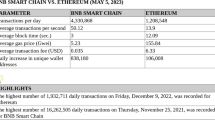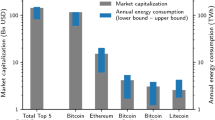Abstract
This paper simulates the block generation process of the mining pool in blockchain system based on the Proof of Work (PoW) consensus protocol, and mainly studies the three issues of block generation time, energy consumption of the mining pool and the number of transactions in the pending transaction pool. The mining pool is abstracted as a queueing system, and the batch service M/M/c queueing model with feedback, vacation, and repairable faults is used to model and analyze this queueing system, the method of matrix-geometric solution is used to solve the stationary distribution of the system. In order to reduce the energy consumption of mining pools and suppress block generation time, this paper introduces a vacation strategy and a feedback mechanism, and verifies the effectiveness of the two strategies through experimental comparison. In addition, this paper studies the optimal revenue of the mining pool based on factors such as transaction fees, block rewards and energy costs, and obtains the computing power and number of miners that maximize the revenue of the mining pool.








Similar content being viewed by others
Change history
07 April 2023
The PDF version of this originally published article was the uncorrected proof
10 April 2023
A Correction to this paper has been published: https://doi.org/10.1007/s12083-023-01483-z
References
Swan M (2015) Blockchain thinking: The brain as a decentralized autonomous corporation. IEEE Technol Soc Mag 34(4), 41–52
Karthika V, Jaganathan S (2019) A quick synopsis of blockchain technology. International Journal of Blockchains and Cryptocurrencies 1(1):54–66
Nakamoto S (2009) Bitcoin: A peer-to-peer electronic cash system [Online]. Available: https://bitcoin.org/bitcoin.pdf
Cao B, Zhang Z, Feng D, Zhang S, Zhang L, Peng M, Li Y (2020) Performance analysis and comparison of PoW, PoS and DAG based blockchains. Digit Commun Netw 6(4):480–485
Liu W, Li Y, Wang X, Peng Y, She W, Tian Z (2021) A donation tracing blockchain model using improved DPoS consensus algorithm. Peer-to-Peer Netw Appl 14(5):2789–2800
Dwork C, Naor M (1992) Pricing via processing or combatting junk mail. In: Annual international cryptology conference, pp 139-147
Han R, Foutris N, Kotselidis C (2019) Demystifying Crypto-Mining: Analysis and Optimizations of memory-hard PoW Algorithms. In: 2019 IEEE International Symposium on Performance Analysis of Systems and Software (ISPASS), pp 22-33
Liao D, Li H, Wang W, Wang X, Zhang M, Chen X (2021) Achieving IoT data security based blockchain. Peer-to-Peer Netw Appl 14(5):2694–2707
Ren W, Hu J, Zhu T, Ren Y, Choo KR (2020) A flexible method to defend against computationally resourceful miners in blockchain proof of work. Inf Sci 507:161–171
Li A, Wei X, He Z (2020) Robust proof of stake: A new consensus protocol for sustainable blockchain systems. Sustainability 12(7):2824
Zhang R, Chan W K (2020) Evaluation of energy consumption in block-chains with proof of work and proof of stake. In: Proceedings of 4th International Conference on Data Mining, Communications and Information Technology (DMCIT 2020), pp 171-176
Zhu Y, Bao Y (2009) M/M/c repairable queue system under nonpreemptive priority. J Syst Eng Electron 31(6):1500–1505. (in Chinese)
Ke J, Chang F, Liu T (2019) M/M/c balking retrial queue with vacation. Qual Technol Quant Manag 16(1):54–66
Kim WS, Lim DE (2016) Analysis of overtaking in M/M/c queues. Comput Ind Eng 101:177–183
Sudhesh R, Azhagappan A (2019) Analysis of an M/M/c queue with heterogeneous servers, balking and reneging. Int J Operational Research 36(3):293–309
Ma Z, Zhang C, Zhang L, Wang S (2021) Energy saving strategy and Nash equilibrium of hybrid P2P networks. J Parallel Distrib Comput 157:145–156
Si Q, Ma Z, Liu F, Wang R (2021) Performance analysis of P2P network with dynamic changes of servers based on M/M/c queuing model. Wirel Netw 27(5):3287–3297
Kumar R, Sharma S (2018) Transient analysis of an M/M/c queuing system with balking and retention of reneging customers. Commun Stat-Theory Methods 47(6):1318–1327
Wang J, Baron O, Scheller-Wolf A (2015) M/M/c queue with two priority classes. Oper Res 63(3):733–749
Ma Z, Chen L, Wang P (2020) Analysis of G-queue with pseudo-fault and multiple working vacations. J Syst Sci Complex 33(4):1144–1162
Li J, Liu L (2017) Performance analysis of a complex queueing system with vacations in random environment. Adv Mech Eng 9(8):1–9
Zhang H, Zhou G (2017) M/M/1 queue with m kinds of differentiated working vacations. J Appl Math Comput 54(1–2):213–227
Kalidass K, Gnanaraj J, Gopinath S, Kasturi R (2014) Transient analysis of an M/M/1 queue with a repairable server and multiple vacations. Int J Mathematics in Operational Research 6(2):193–216
An H, Wang Y, Jin S (2021) Research on threshold strategy of cloud user access under single sleep mechanism. Journal of Yanshan University 45(1):70–75. (in Chinese)
Li J, Yuan Y, Wang S, Wang F (2018) Transaction queuing game in bitcoin blockchain. In: 2018 IEEE Intelligent Vehicles Symposium (IV), pp 114-119
Srivastava R (2019) Mathematical assessment of blocks acceptance in blockchain using Markov model. International Journal of Blockchains and Cryptocurrencies 1(1):42–53
Li Q, Ma J, Chang Y, Ma F, Yu H (2019) Markov processes in blockchain systems. Computational Social Networks 6(1):1–28
Fan J, Ma Z, Zhang Y, Zhang C (2020) Analysis of blockchain system based on M(M1, M2)/1 vacation queueing model. J Supercomput 77(4):3673–3694
Ma J, Li Q (2021) Sensitivity-based optimization for blockchain selfish mining. In: 2021 International Conference on Algorithmic Applications in Management, pp 329-343
Li Q, Chang Y, Wu X, Zhang G (2021) A new theoretical framework of pyramid markov processes for blockchain selfish mining. J Syst Sci Syst Eng 30(6):667–711
Tian N, Yue D (2002) The quasi birth and death process and matrix-geometric solution. Beijing, Science Press pp 39-77. (in Chinese)
Neuts MF (1981) Matrix-geometric solution in stochastic models. Baltimore, Johns Hopkins University Press
Wu D, Takagi H (2006) M/G/1 queue with multiple working vacations. Perform Eval 63(7):654–681
Yu S, Liu Z, Wu J (2016) Equilibrium strategies of the unobservable M/M/1 queue with balking and delayed repairs. Appl Math Comput 290:56–65
Acknowledgements
This work was supported in part by the National Natural Science Foundation of China under Grant Nos. 61973261, 61872311, Natural Science Foundation of Hebei Province under Grant Nos. A2020203010, A2018203088.
Author information
Authors and Affiliations
Corresponding author
Ethics declarations
Conflicts of interest
The authors declare that they have no known competing financial interests or personal relationships that could have appeared to influence the work reported in this paper.
Rights and permissions
Springer Nature or its licensor (e.g. a society or other partner) holds exclusive rights to this article under a publishing agreement with the author(s) or other rightsholder(s); author self-archiving of the accepted manuscript version of this article is solely governed by the terms of such publishing agreement and applicable law.
About this article
Cite this article
Zhang, C., Ma, Z., Liu, L. et al. Modeling & analysis of block generation process of the mining pool in blockchain system. Peer-to-Peer Netw. Appl. 16, 475–487 (2023). https://doi.org/10.1007/s12083-022-01359-8
Received:
Accepted:
Published:
Issue Date:
DOI: https://doi.org/10.1007/s12083-022-01359-8




